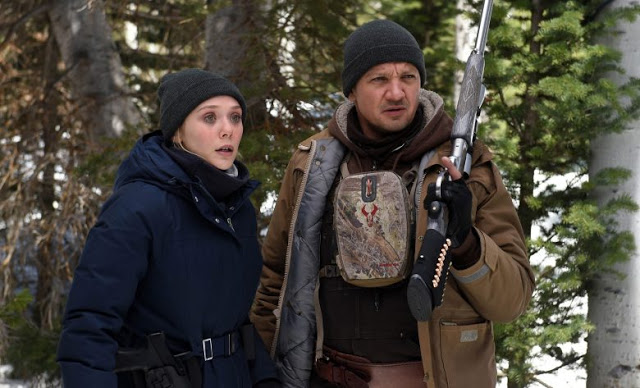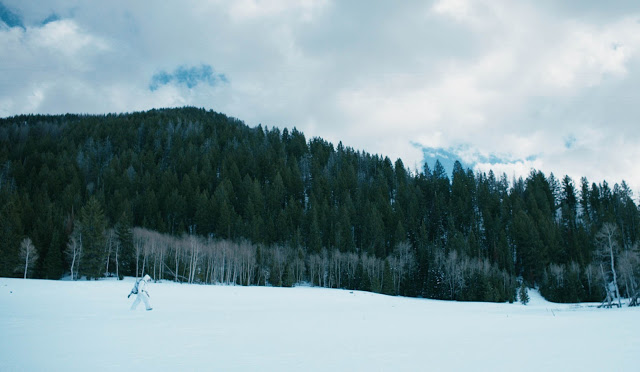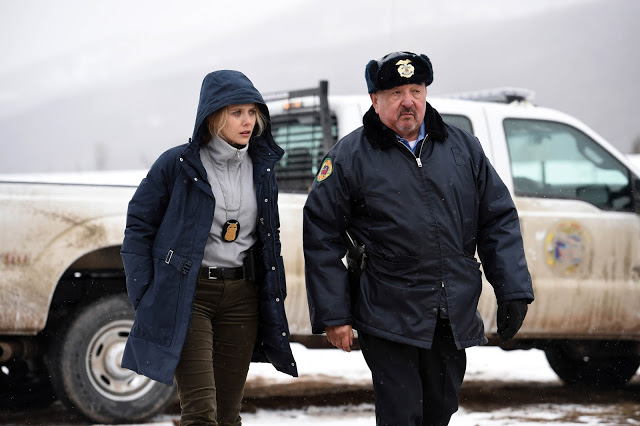The chill runs bone-deep in Wind River, the astute and mournful second feature from Taylor Sheridan. After penning two electric screenplays that sweltered in the suffocating Southwest heat, the actor-turned-writer-turned-director has turned his gaze north and flipped his thermometer upside-down. Taking place on the titular Indian reservation in Wyoming (filming took place in Utah), Sheridan’s newest movie is cold and stark, the snow blanketing its landscapes and its characters like a paralytic force. The opening shot, of a teenage girl racing barefoot across a frozen plain in the dead of night, will make you shiver. Don’t expect to warm up anytime soon.
Not that Wind River is emotionally icy or remote. Quite the contrary; it’s a lively crime picture that’s also unusually elegiac, as interested in grief as it is in thrills. Sheridan’s protagonists may be ruthless—Benicio Del Toro’s vengeful assassin in Sicario can still trigger nightmares, while Ben Foster’s wolfish reprobate in Hell or High Water gunned down innocents without hesitation—but they are also motivated by anger and loss. Wind River’s hero, a Fish and Wildlife agent named Cory Lambert, is a literal hunter, a killing machine with a rifle on his back and a hole in his heart.
He is perhaps too gifted a killer to be entirely credible. Played with steely sensitivity by Jeremy Renner, Cory is an expert marksman and an inveterate tracker, the kind of man who can glance at some imprints in the ground and instantly discern where his quarry was headed. His supreme competence renders him somewhat artificial, and Renner initially struggles to give his character real dimension. But as the movie progresses, Renner’s understated performance gains shape, steering Cory—who lost a daughter years ago—away from the cliché of the wounded warrior and into something more slippery and complex.
It is hardly happenstance that this process coincides with the arrival of Jane Banner (a very good Elizabeth Olsen), the FBI agent who’s dispatched to the reservation to investigate after Cory discovers the body of a teenage girl (Kelsey Asbille) frozen in the snow. Jane is at first blush Cory’s opposite: green, weak, and hopelessly out of her depth. (Certainly she is unprepared for the savagery of the weather, leading to a quietly wrenching scene where she is forced to borrow a dead girl’s clothes from her bereaved grandmother.) But she is also tenacious, and Olsen, in a marvelously nuanced turn (her best since her stunning debut in Martha Marcy May Marlene), spins her into a fascinating figure, determined yet terrifyingly vulnerable. The uneasy partnership that develops between Cory and Jane becomes the movie’s core, adding heft to what is, in bold strokes, a fairly conventional murder mystery.
The same is true for the film’s setting. Wind River’s whodunit storyline may be familiar, but its geography and ambiance are gratifyingly specific. Sheridan peppers the proceedings with throwaway details—such as how an officer needs to use a chainsaw to unwedge a corpse from the frigid tundra, or how the heavily wooded terrain means “you have to drive 50 miles to go 5”—that give the movie a strong sense of place. And of course, there is the broader subtext of rapacious imperialism, as Sheridan obliquely chronicles how the Indian community has been marginalized, forced to retreat further and further inward as white America continuously colonizes the heartland.
In this latter regard, Wind River is simultaneously laudable and frustrating. To be sure, the film shines a light on a people who are largely neglected, both by society and by cinema. And it is of course satisfying to spend time with actors like Graham Greene, who plays the reservation’s wry and crusty sheriff, and Gil Birmingham (Jeff Bridges’ partner in Hell or High Water), who portrays the victim’s stricken father. But at the same time, Sheridan’s screenplay—centering on a dead Native American girl and the white man and woman seeking justice on her behalf—can feel overdetermined, even judgmental. (The villains, when they are finally and anticlimactically revealed, prove to be crudely drawn brutes.) There is something scolding and schematic about Wind River’s grisly plot, even if the movie is also intelligent and empathetic.
And exciting, too. For all its subtlety, Wind River is still a crime thriller, and Sheridan recognizes the need to sate viewers’ appetites for action and suspense. He proves pretty good at it, if less adept than Denis Villeneuve and David Mackenzie, the talented directors who adapted his prior scripts. If nothing else, Sheridan demonstrates his devotion to The Silence of the Lambs. The character of Jane, a young female fed who thirsts to establish herself in a world dominated by men, is plainly a cinematic descendant of Clarice Starling, while a number of Wind River’s set pieces—from a chase where the hero’s vision is impaired to a misdirected knock on the door—echo Jonathan Demme’s classic Oscar winner. It can feel like imitation, but it still gets your heart pumping, even if Sheridan lacks Demme’s gift for spatial clarity; in one crucial scene, he fails to properly delineate the various players, diluting its impact and trading tension for confusion.
But while Wind River works reasonably well as a piece of pulp (albeit with a climax that feebly apes Mad Max), it’s more meaningful as a hymn of melancholy. Sheridan is less interested in the dead than the living; he wants to explore how the sting of tragedy—in particular the loss of a child—never really dissipates, but instead calcifies and metastasizes. That’s why two of the movie’s most memorable scenes are two of its quietest, first when Cory explains to a bereft father the importance of grieving, and later when he solemnly tells Jane the story of his own daughter’s murder. There’s so much sorrow lingering in the film that it risks broaching miserabilism, but the perceptive performances from Renner and Olsen—along with the gentle, stirring score from Nick Cave and Warren Ellis—make its sadness resonant rather than punishing.
Besides, the movie is just too entertaining to be unpleasant. By the time a shirtless Jon Bernthal shows up, anchoring Wind River’s most robust and appalling set piece, the film has long since hooked you with its inherently compelling tale of gone girls, mad men, and a woman trying to fight through the cold and the muck. The genre elements you’ve seen before, so they’re easy enough to shake off. But it’s the location’s particularity—and Olsen’s tentative pluck—that cling to you like shards of ice.
Jeremy Beck is the editor-in-chief of MovieManifesto. He watches more movies and television than he probably should.





